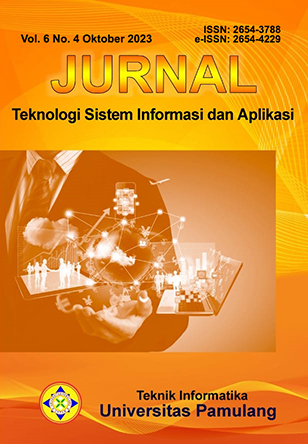Tata Kelola Rekam Medis Berbasis Elektronik Pada Kunjungan Harian Pasien Rawat Jalan Menggunakan Metode RAD
Keywords:
Information System, Electronic Medical Records, Daily Visits, Outpatients, RAD MethodAbstract
Problems faced in the governance of electronic-based medical records in outpatient daily visits include the lack of governance standards, inconsistencies in data collection, and low interoperability between existing systems. These problems can lead to errors in diagnosis, less efficient treatment, and increased patient safety risks. In order to solve these problems, the RAD (Rapid Application Development) method was proposed as a solution. This method involves a needs analysis phase conducted by listening to stakeholders, identifying existing problems, and designing a suitable solution. The use of the RAD method can provide significant results. After the implementation of the RAD method, the results showed significant improvement. Clear and measurable governance standards have been implemented to ensure consistency and accuracy in data collection. In addition, faster system development is also possible through the implementation of the RAD method, thus overcoming the technical challenges associated with electronic medical records. Overall, the results of applying the RAD method in the governance of electronic-based medical records on daily outpatient visits have successfully addressed the existing problems. This method can be widely applied in clinical practice to improve efficiency, quality of care and patient safety.
References
Arifin, I., Heltiani, N., & Fattolah, D. (2023). Perancangan Sistem Informasi Registrasi Pasien Rawat Jalan RSUD Kabupaten Labong. Jurnal Manajemen Informasi Kesehatan, 8(1), 27-37. https://doi.org/10.51851/jmis.v8i1.398
Hasanudin, M., Khoirudin, H. M., & Amroni, W. A. (2019). Aplikasi E-Commerce Sistem Informasi Penjualan Rolling Door Berbasis Rapid Application Development. PETIR, 12(1), 64–71. https://doi.org/10.33322/petir.v12i1.368
Imran, Y. V., Sufyana, C. M., & Setiatin, S. (2021). Perancangan Sistem Informasi Rekam Medis Pasien& Rawat Jalan Berbasis Web Di RSUD Pasaman Barat. Explore: Jurnal Sistem Informasi Dan Telematika, 12(2), 153–165. https://doi.org/10.36448/jsit.v12i2.2077
Israwati, Setiatin, S., & Abdussalaam, F. (2021). Perancangan Sistem Informasi Peminjaman Dan Pengembalian Rekam Medis Rawat Jalan Di Rumah Sakit Muhammadiyah Bandung. Jurnal Ilmiah Perekam Dan Informasi Kesehatan Imelda (JIPIKI), 6(2), 139–151. https://doi.org/10.52943/jipiki.v6i2.575
Kurniadi, D., Mulyani, A., & Annisa, D. A. N. (2020). Rancang Bangun Sistem Informasi Rekam Medis Pada Klinik Menggunakan metode extreme programing. Jurnal Algoritma, 17(2), 440–451. https://doi.org/10.33364/algoritma/v.17-2.440
Majiid, N. S., Dewi, A. S., Syahidin, Y., & Setiatin, S. (2021). Perancangan Sistem Informasi Kunjungan Harian Pasien Rawat Jalan Di UPT Puskesmas Cijerah, Jurnal Sistem Informasi dan Manajemen (JURSIMA), 9(2), 85-94. https://doi.org/10.47024/js.v9i2.280
Meilani, S., & Sari, I. (2021). Perancangan Sistem Informasi IGD Menggunakan Microsoft Visual Studio 2010 Di Rumah Sakit X. Jurnal Indonesia Sosial Teknologi, 2(9), 1650–1659. https://doi.org/10.36418/jist.v2i9.233
Pratomo, R. D., & Widiasari, M.MT, Dr. I. (2022). Perancangan Sistem Informasi Covid-19 Berbasis Website Dengan PHP Menggunakan Metode Rapid Application Development (RAD). Jurnal Pendidikan Teknologi Informasi (JUKANTI), 5(2), 42–49. https://doi.org/10.37792/jukanti.v5i2.526
Raihan, F. M. (2021). Perancangan Sistem Informasi Rekam Medis Pada Klinik Saffira Sentra Medika Batam. Jurnal Sains, Nalar, dan Aplikasi Teknologi Informasi, 1(1), 47-56.
Rangga, R., Syahidin, Y., & Hidayati, M. (2021). Perancangan Sistem Informasi Kelengkapan Rekam Medis Rawat Jalan Dengan Metode V-Model. Jurnal Teknologi Informasi, 5(2). https://doi.org/10.31326/sistek.v3i2.960
Suryadi, A., Arif, Y. W. T., & Novitasari, N. S. (2022). Rancang Bangun Sistem Informasi Rekam Medis Klinik Rawat Jalan Berbasis Web. Infokes: Jurnal Ilmiah Rekam Medis Dan Informatika Kesehatan, 12(1), 37–43. https://doi.org/10.47701/infokes.v12i1.1498
Tryasmoro, F., Purbasari, D., & Rahayu, R. (2022). Tata Kelola Sim-Rs Dalam Pencegahan Ketidaklengkapan Sensus Harian Rawat Inap Di Rumah Sakit Ciremai Tingkat III 03.06.01 Cirebon. Jurnal Kesehatan Mahardika, 8(2), 31–38. https://doi.org/10.54867/jkm.v8i2.87
Yusnia, R., Setiatin, S., Nadiroh, W., & Sufyana, C. M. (2021). Perancangan Sistem Informasi Retensi Rekam Medis Pasien Rawat Inap Menggunakan Visual Studio 2010 Di Rumah Sakit Jasa Kartini Tasikmalaya. Jurnal Health Sains, 2(8), 1049–1062. https://doi.org/10.46799/jhs.v2i8.252
Zalukhu, S., & Handriani, I. (2019). Analisa Dan Perancangan Aplikasi Sistem Inventory (Studi Kasus: Pt. Cakra Medika Utama). JSAI (Journal Scientific and Applied Informatics), 2(1), 116–122. https://doi.org/10.36085/jsai.v2i1.153
Downloads
Published
How to Cite
Issue
Section
License
Copyright (c) 2023 Linggar Adjie Pradysta, Yuda Syahidin, Irda Sari

This work is licensed under a Creative Commons Attribution-NonCommercial 4.0 International License.
Authors who publish with this journal agree to the following terms:
- Authors retain copyright and grant the journal right of first publication with the work simultaneously licensed under a Creative Commons Attribution License that allows others to share the work with an acknowledgement of the work's authorship and initial publication in this journal.
- Authors are able to enter into separate, additional contractual arrangements for the non-exclusive distribution of the journal's published version of the work (e.g., post it to an institutional repository or publish it in a book), with an acknowledgement of its initial publication in this journal.
- Authors are permitted and encouraged to post their work online (e.g., in institutional repositories or on their website) prior to and during the submission process, as it can lead to productive exchanges, as well as earlier and greater citation of published work (See The Effect of Open Access).
Jurnal Teknologi Sistem Informasi dan Aplikasi have CC BY-NC or an equivalent license as the optimal license for the publication, distribution, use, and reuse of scholarly work.
In developing strategy and setting priorities, Jurnal Teknologi Sistem Informasi dan Aplikasi recognize that free access is better than priced access, libre access is better than free access, and libre under CC BY-NC or the equivalent is better than libre under more restrictive open licenses. We should achieve what we can when we can. We should not delay achieving free in order to achieve libre, and we should not stop with free when we can achieve libre.
This work is licensed under a Creative Commons Attribution-NonCommercial 4.0 International (CC BY-NC 4.0) License
YOU ARE FREE TO:
- Share - copy and redistribute the material in any medium or format
- Adapt - remix, transform, and build upon the material for any purpose, even commercially.
- The licensor cannot revoke these freedoms as long as you follow the license terms



_2020_-_7(2)_2024_-_Thumbnail.png)












